Contribution of Atmospheric Depositions to Inventory of Nutrients in the Coastal Waters of Crimea
Abstract
1. Introduction
2. Materials and Methods
2.1. Precipitation Sampling
2.2. Chemical Analysis
2.3. Calculation of the Volume Weighted Mean Concentrations
- C is the VWM concentration, µmol L−1;
- Ci is the nutrient concentration of each sample, µmol L−1;
- Ri is the corresponding rainfall amount for each sample, mm.
2.4. Calculation of Nitrogen Concentrations Using the Multiple Nonlinear Regression Equation
(−0.0004Vx3 + 0.0003Vx2 − 0.0009Vx + 0.9946)·(0.0004Ta2 − 0.0109Ta + 1.0518)
- Ri—number of precipitations, mm;
- d—number of days without precipitations;
- f—relative air humidity, %
- Vy, Vx—wind direction vectors;
- Ta—air temperature, °C.
3. Results and Discussion
4. Conclusions
Author Contributions
Funding
Institutional Review Board Statement
Informed Consent Statement
Data Availability Statement
Conflicts of Interest
References
- Michaels, A.F.; Siegel, D.A.; Johnson, R.J.; Knap, A.H.; Galloway, J. Episodic inputs of atmospheric nitrogen to the Sargasso Sea: Contributions to new production and phytoplankton blooms. Glob. Biogeochem. Cycles 1993, 7, 339–351. [Google Scholar] [CrossRef]
- Spokes, L.J.; Yeatman, S.G.; Corneli, S.; Jickells, T.D. Nitrogen deposition to the eastern Atlantic Ocean: The importance of south-easterly flow. Tellus Ser. B 2000, 52, 37–49. [Google Scholar] [CrossRef]
- Loye-Pilot, M.D.; Klein, C.; Martin, J.M. Major inorganic elements in north western Mediterranean aerosols: Concentrations and sources, Estimation of dry deposition of soluble inorganic nitrogen. In Water Pollution Reports; Martin, J.M., Barth, H., Eds.; European Union: Brussels, Belgium, 1993; Volume 20, pp. 271–277. [Google Scholar]
- Troost, T.; Blaas, M.; Los, F. The role of atmospheric deposition in the eutrophication of the North Sea: A model analysis. J. Mar. Syst. 2013, 125, 101–112. [Google Scholar] [CrossRef]
- Lønborg, C.; Müller, M.; Butler, E.C.; Jiang, S.; Ooi, S.K.; Trinh, D.H.; Wong, P.Y.; Ali, S.M.; Cui, C.; Siong, W.B.; et al. Nutrient cycling in tropical and temperate coastal waters: Is latitude making a difference? Estuar. Coast. Shelf Sci. 2021, 262, 107571. [Google Scholar] [CrossRef]
- Jickells, T. The role of air-sea exchange in the marine nitrogen cycle. Biogeosciences 2006, 3, 271–280. [Google Scholar] [CrossRef]
- Ngatia, L.; Grace, J.M., III; Moriasi, D.; Taylor, R. Nitrogen and phosphorus eutrophication in marine ecosystems. In Monitoring of Marine Pollution; Fouzia, H.B., Ed.; IntechOpen: London, UK, 2019. [Google Scholar] [CrossRef]
- Diaz, R.J.; Rosenberg, R. Spreading dead zones and consequences for marine ecosystems. Science 2008, 321, 926–929. [Google Scholar] [CrossRef] [PubMed]
- Zavialov, P.O.; Makkaveev, P.N.; Konovalov, B.V.; Osadchiev, A.; Khlebopashev, P.V.; Pelevin, V.; Grabovskiy, A.B.; Izhitskiy, A.S.; Goncharenko, I.V.; Soloviev, D.M.; et al. Hydrophysical and hydrochemical characteristics of the sea areas adjacent to the estuaries of small rivers of the Russian coast of the Black Sea. Oceanology 2014, 54, 265–280. [Google Scholar] [CrossRef]
- Polyakova, T.V.; Polyakova, A.V. Variability Phytoplankton Community of North-Eastern Black Sea under the Influence of Natural and Anthropogenic Factors//Issues of Modern Algology. 2016. Available online: http://algology.ru/958 (accessed on 15 December 2022). (In Russian).
- Polyakova, T.V.; Polyakova, A.V. Ecology of plankton in the northeastern Black Sea. Pap. Mosc. Soc. Nat. Testers 2016, 62, 36–61. (In Russian) [Google Scholar]
- Kos’yan, R.; Podymov, I.; Pykhov, N. (Eds.) Dynamical Processes in the Sea Nearshore Zone; Scientific World: Moscow, Russia, 2003; 320p. (In Russian) [Google Scholar]
- Report on the State and Protection of the Environment of Sevastopol. Available online: https://spn.sev.gov.ru/ekologicheskoe-sostoyanie-sevastopolya/doklad-o-sostoyanii-i-ob-okhrane-okruzhayushchey-sredy-goroda-sevastopolya/ (accessed on 15 December 2022). (In Russian)
- Moiseenko, O.G.; Khoruzhiy, D.; Medvedev, E. Carbonate system of the Chernaya river and biogeochemical barrier zone of the Chernaya River—The Sevastopol bay (the Black Sea). Phys. Oceanogr. 2014, 6, 47–60. (In Russian) [Google Scholar]
- Mezenceva, I.V.; Malchenko, Y.A. Integrated approach in the organization of marine pollution monitoring in coastal water areas in Sevastopol. In Proceedings of the N.N. Zubov State Oceanographic Institute; “Artifex” Publishing House: Obninsk, Russia, 2015; pp. 326–339. (In Russian). [Google Scholar]
- Gruzinov, V.M.; Dyakov, N.N.; Mezenceva, I.V.; Malchenko, Y.A.; Zhohova, N.V.; Korshenko, A.N. Sources of Coastal Water Pollution near Sevastopol. Oceanology 2019, 59, 523–532. [Google Scholar] [CrossRef]
- Verzhevskaia, L.V.; Minkovskaya, R.Y. Investigation of Human Impacton the Coastal Waters of Sevastopol Region. In Proceedings of the V.I. Vernadsky Crimean Federal University, Geoecology and Natural Management: Actual Issues of Science, Practice and Education: Materials of the Pan-Russian Scientific and Practical Conference, Simferopol, Russia, 17–20 October 2018; pp. 99–102. (In Russian). [Google Scholar]
- Ferreira, J.; Andrade, D.I.; Fuziki, M.E.K.; de Almeida, L.N.B.; Colpini, L.M.S.; Lenzi, G.G.; Tusset, A.M. Catalytic Systems in the Reduction of Nitrogen Oxide Emissions in Diesel-Powered Trucks. Sustainability 2022, 14, 6662. [Google Scholar] [CrossRef]
- Ma, R.; Li, K.; Guo, Y.; Zhang, B.; Zhao, X.; Linder, S.; Guan, C.; Chen, G.; Gan, Y.; Meng, J. Mitigation potential of global ammonia emissions and related health impacts in the trade network. Nat. Commun. 2021, 12, 6308. [Google Scholar] [CrossRef] [PubMed]
- Mahowald, N.; Jickells, T.D.; Baker, A.R.; Artaxo, P.; Benitez-Nelson, C.R.; Bergametti, G.; Bond, T.C.; Chen, Y.; Cohen, D.D.; Herut, B.; et al. Global distribution of atmospheric phosphorus sources, concentrations and deposition rates, and anthropogenic impacts. Glob. Biogeochem. Cycles 2008, 22, GB4026. [Google Scholar] [CrossRef]
- Minakova, E.A.; Shlychkov, A.P. Losses of Nutrients with Atmospheric Depositions in the Basin of the Moddle and Lower Volga//Regional Environmental Issues. 2018. Available online: https://cyberleninka.ru/article/n/vypadeniya-biogennyh-veschestv-s-atmosfernymi-osadkami-v-basseyne-sredney-i-nizhney-volgi (accessed on 15 December 2022). (In Russian).
- Jickells, T. Atmospheric inputs of metals and nutrients to the oceans: Their magnitude and effects. Mar. Chem. 1995, 48, 199–214. [Google Scholar] [CrossRef]
- Im, U.; Christodoulaki, S.; Violaki, K.; Zarmpas, P.; Kocak, M.; Daskalakis, N.; Mihalopoulos, N.; Kanakidou, M. Atmospheric deposition of nitrogen and sulfur over southern Europe with focus on the Mediterranean and the Black Sea. Atmos. Environ. 2013, 81, 660–670. [Google Scholar] [CrossRef]
- Xing, J.; Song, J.; Yuan, H.; Li, X.; Li, N.; Duan, L.; Kang, X.; Wang, Q. Fluxes, seasonal patterns and sources of various nutrient species (nitrogen, phosphorus and silicon) in atmospheric wet deposition and their ecological effects on Jiaozhou Bay, North China. Sci. Total Environ. 2017, 576, 617–627. [Google Scholar] [CrossRef]
- Barile, P.; Lapointe, B. Atmospheric nitrogen deposition from a remote source enriches macroalgae in coral reef ecosystems near Green Turtle Cay, Abacos, Bahamas. Mar. Pollut. Bull. 2005, 50, 1262–1272. [Google Scholar] [CrossRef]
- Gonz’alez-De Zayas, R.; Merino-Ibarra, M.; Matos-Pupo, F.; Soto-Jim´enez, M.F. Atmospheric deposition of nitrogen to a caribbean coastal zone (Cayo coco, Cuba): Temporal trends and relative importance as a nitrogen source. Water Air Soil Pollut. 2011, 223, 1125–1136. [Google Scholar] [CrossRef]
- Manual on Air Pollution Control, Moscow. 1991. Available online: https://docs.cntd.ru/document/1200036406 (accessed on 15 December 2022). (In Russian).
- Bordovskiy, O.K.; Ivanenkov, V.N. (Eds.) Metody Gidrokhimicheskikh Issledovaniy Okeana [Methods of Hydro-Chemical Ocean Studies]; Nauka: Moscow, Russia, 1978; 271p. (In Russian) [Google Scholar]
- Solorzano, L. Determination of ammonia in natural waters by phenolhypochlorite method. Limnol. Oceanogr. 1969, 14, 799–801. [Google Scholar]
- Bhuyan, P.; Ahmed, S.; Hopke, P.K.; Hoque, R.R. Understanding the Chemistry and Sources of Precipitation Ions in the mid-Brahmaputra Valley of Northeastern India. Aerosol Air Qual. Res. 2020, 20, 2690–2704. [Google Scholar] [CrossRef]
- Varenik, A.V. Applying the Brandon Method to Estimate the Concentration of Inorganic Nitrogen in Precipitation. Russ. Meteorol. Hydrol. 2019, 44, 326–330. [Google Scholar] [CrossRef]
- Efimov, V.V.; Volodin, E.M.; Anisimov, A.E. Modeling of the Black Sea Region Climate Changes in the XXI Century. Phys. Oceanogr. 2015, 2, 3–13. [Google Scholar]
- Varenik, A.; Kalinskaya, D. The Effect of Dust Transport on the Concentration of Chlorophyll-A in the Surface Layer of the Black Sea. Appl. Sci. 2021, 11, 4692. [Google Scholar] [CrossRef]
- Schichtel, B.A.; Gebhart, K.A.; Morris, K.H.; Cheatham, J.R.; Vimont, J.; Larson, R.S.; Beachley, G. Long-term trends of wet inorganic nitrogen deposition in Rocky Mountain National Park: Influence of missing data imputation methods and associated uncertainty. Sci. Total Environ. 2019, 687, 817–826. [Google Scholar] [CrossRef]
- Shou, C.-Y.; Tian, Y.; Zhou, B.; Fu, X.-J.; Zhu, Y.-J.; Yue, F.-J. The Effect of Rainfall on Aquatic Nitrogen and Phosphorus in a Semi-Humid Area Catchment, Northern China. Int. J. Environ. Res. Public Health 2022, 19, 10962. [Google Scholar] [CrossRef] [PubMed]
- Tabunshchik, V.; Gorbunov, R.; Gorbunova, T. Anthropogenic Transformation of the River Basins of the Northwestern Slope of the Crimean Mountains (The Crimean Peninsula). Land 2022, 11, 2121. [Google Scholar] [CrossRef]
- Varenik, A.V.; Konovalov, S.K. Variations in Concentrations and Ratio of Soluble Forms of Nutrients in Atmospheric Depositions and Effects for Marine Coastal Areas of Crimea, Black Sea. Appl. Sci. 2021, 11, 11509. [Google Scholar] [CrossRef]
- Kumari, V.R.; Neeraja, B.; Rao, D.N.; Ghosh, V.R.D.; Rajula, G.R.; Sarma, V.V.S.S. Impact of atmospheric dry deposition of nutrients on phytoplankton pigment composition and primary production in the coastal Bay of Bengal. Environ. Sci. Pollut. Res. 2022, 29, 82218–82231. [Google Scholar] [CrossRef] [PubMed]
- Ventura, A.; Simões, E.F.C.; Almeida, A.S.; Martins, R.; Duarte, A.C.; Loureiro, S.; Duarte, R.M.B.O. Deposition of Aerosols onto Upper Ocean and Their Impacts on Marine Biota. Atmosphere 2021, 12, 684. [Google Scholar] [CrossRef]
- Xie, L.; Gao, X.; Liu, Y.; Yang, B.; Wang, B.; Zhao, J.; Xing, Q. Atmospheric wet deposition serves as an important nutrient supply for coastal ecosystems and fishery resources: Insights from a mariculture area in North China. Mar. Pollut. Bull. 2022, 182, 114036. [Google Scholar] [CrossRef]
- Scheme of Complex Use and Protection of Water Bodies of the River Basins of the Republic of Crimea. Book 1 General Characteristics of River Basins Located in the Territory of the Republic of Crimea. Available online: https://gkvod.rk.gov.ru/uploads/gkvod/attachments//d4/1d/8c/d98f00b204e9800998ecf8427e/phpTxr9ug_2.pdf (accessed on 15 December 2022). (In Russian)
- Richon, C.; Dutay, J.-C.; Dulac, F.; Wang, R.; Balkanski, Y.; Nabat, P.; Aumont, O.; Desboeufs, K.; Laurent, B.; Guieu, C.; et al. Modeling the impacts of atmospheric deposition of nitrogen and desert dust-derived phosphorus on nutrients and biological budgets of the Mediterranean Sea. Prog. Oceanogr. 2018, 163, 21–39. [Google Scholar] [CrossRef]
- Nixon, S.W.; Ammerman, J.W.; Atkinson, L.P.; Berounsky, V.M.; Billen, G.; Boicourt, W.C.; Boynton, W.R.; Church, T.M.; Dioro, D.M.; Elmgren, R.; et al. The fate of nitrogen and phosphorus at the land-sea margin of the North Atlantic Ocean. Biogeochemistry 1996, 35, 141–180. [Google Scholar] [CrossRef]
- Valigura, R.A.; Alexander, R.B.; Castro, M.S.; Meyers, T.P.; Paerl, H.W.; Stacey, P.E.; Turner, R.E. Nitrogen Loading in Coastal Water Bodies: An Atmospheric Perspective; American Geophysical Union: Washington, DC, USA, 2001. [Google Scholar] [CrossRef]
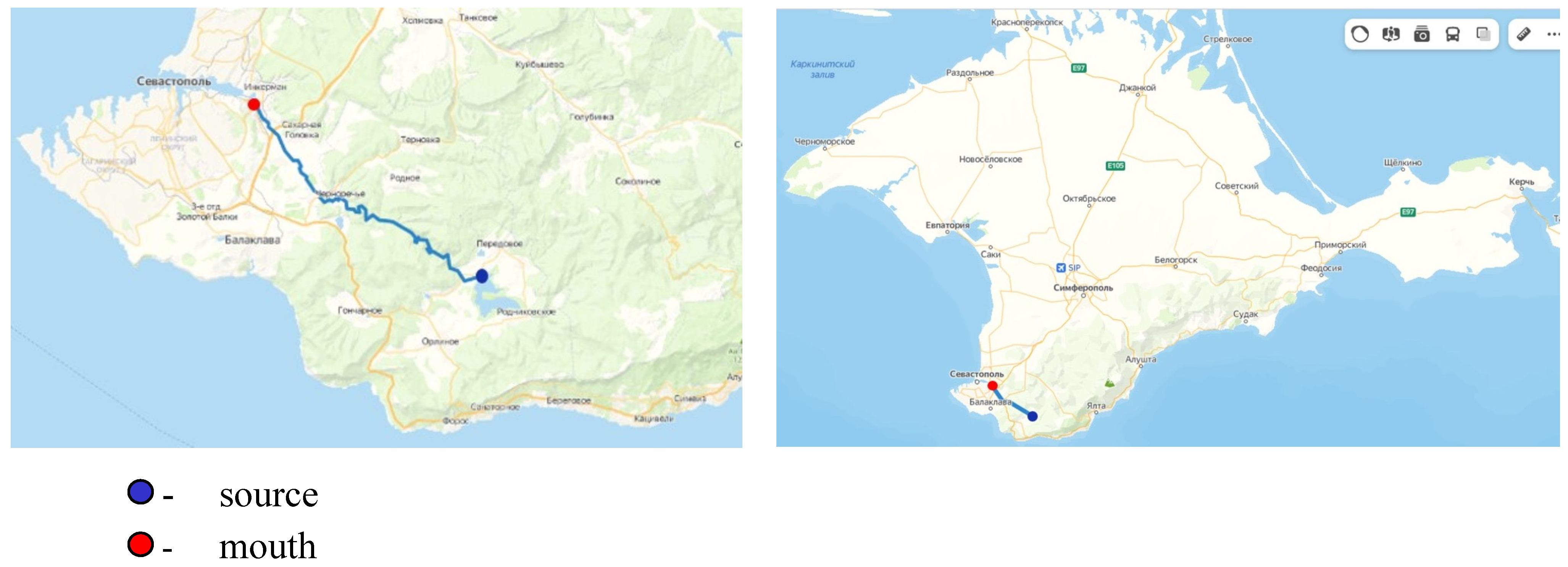

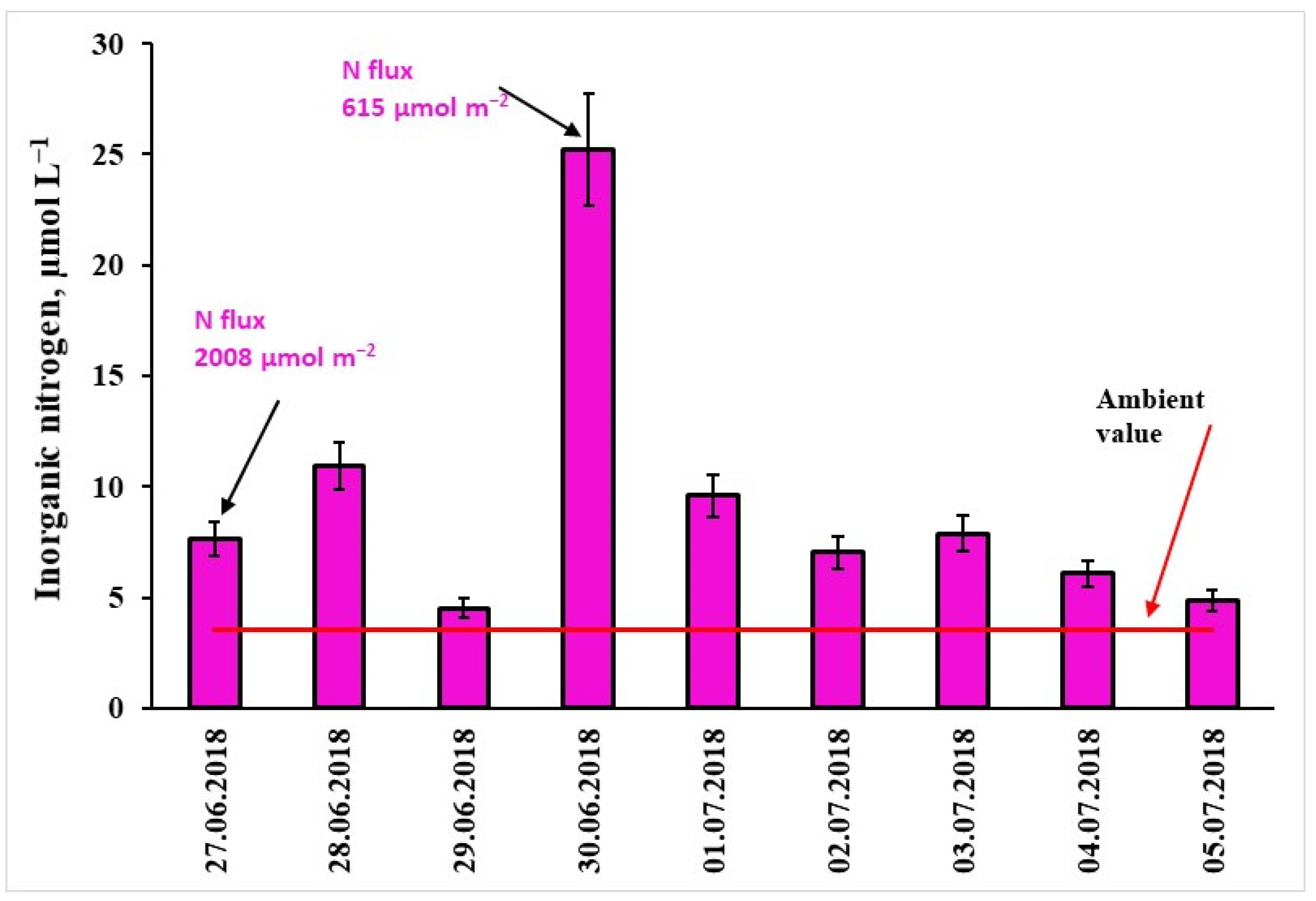
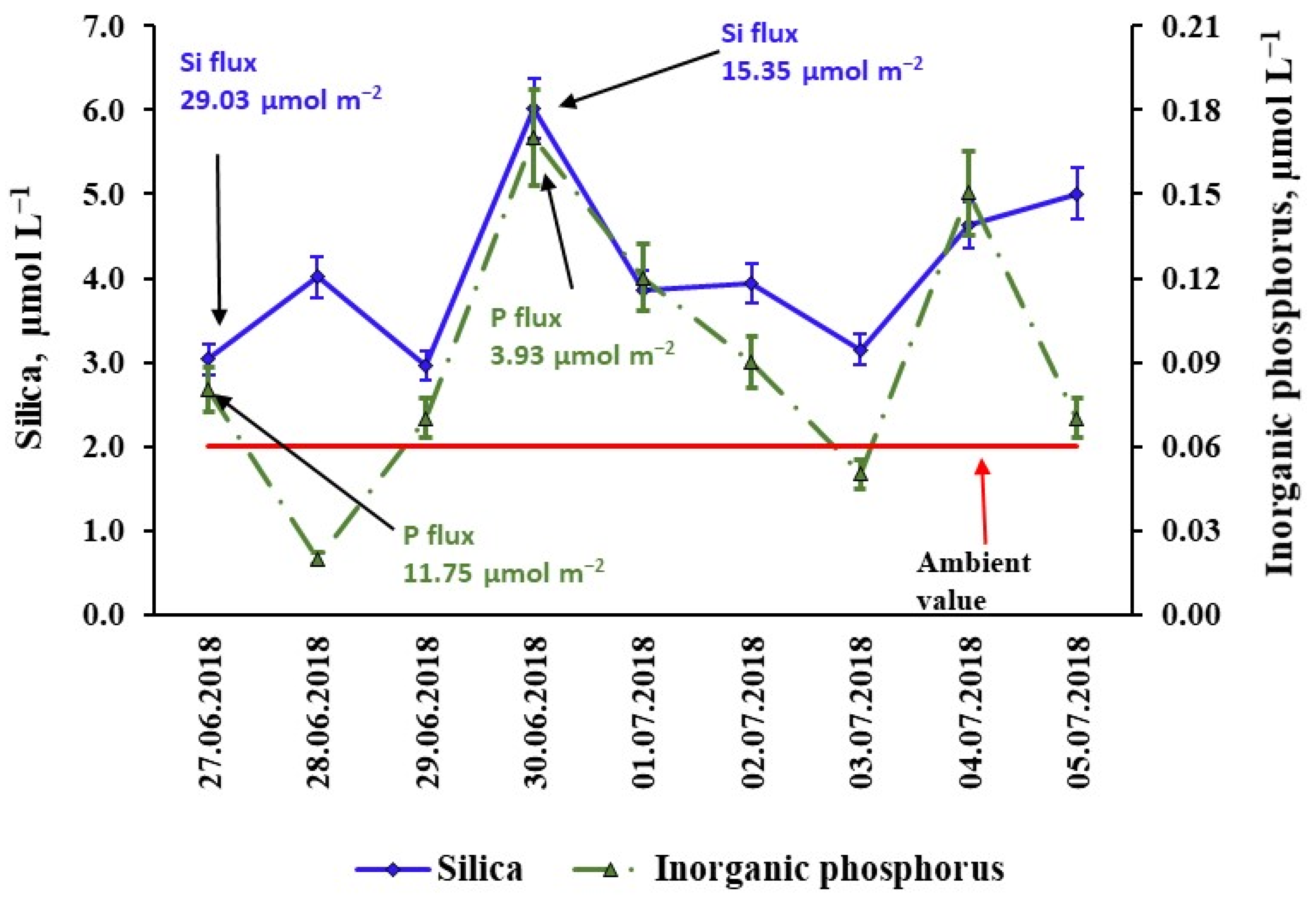
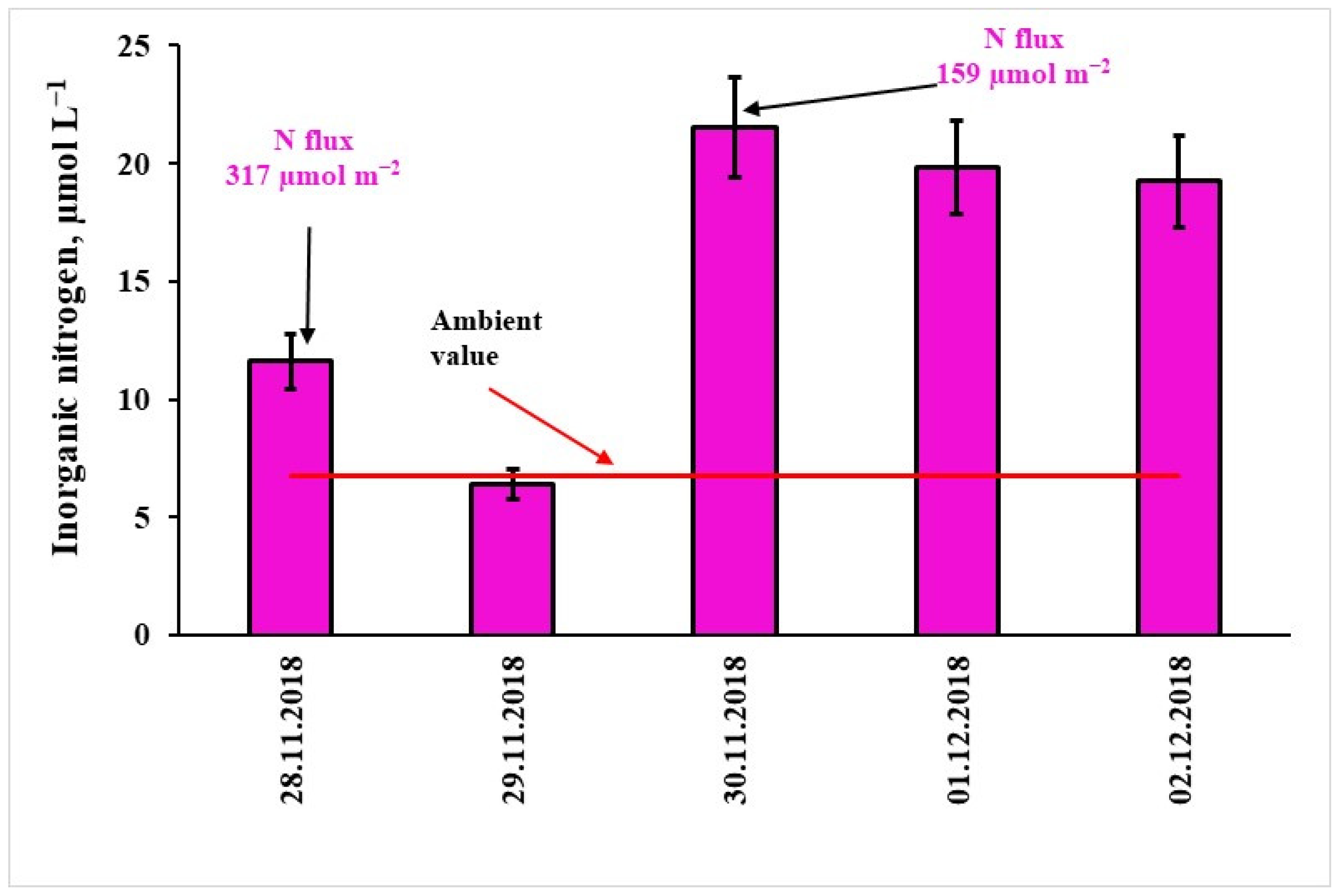

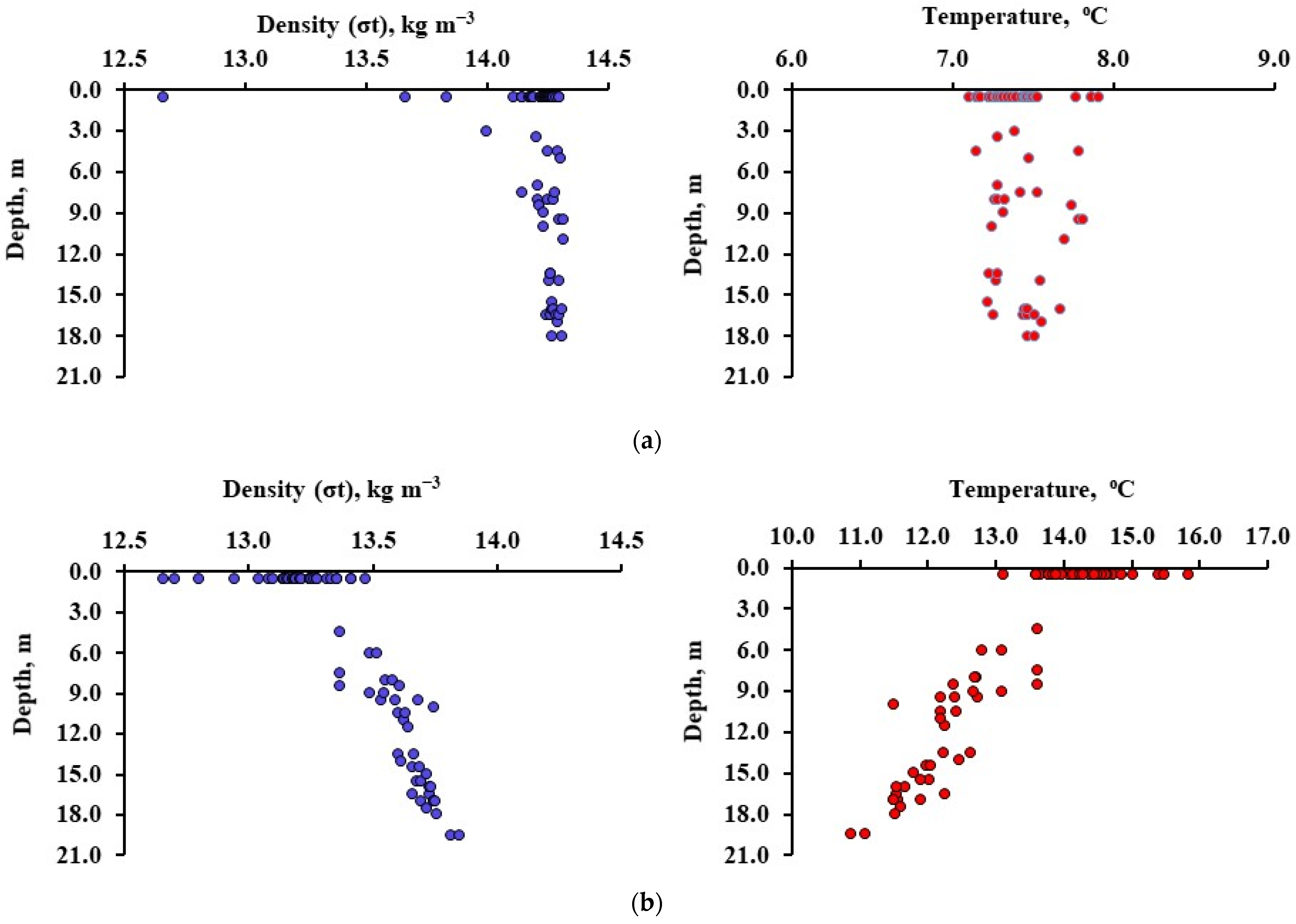
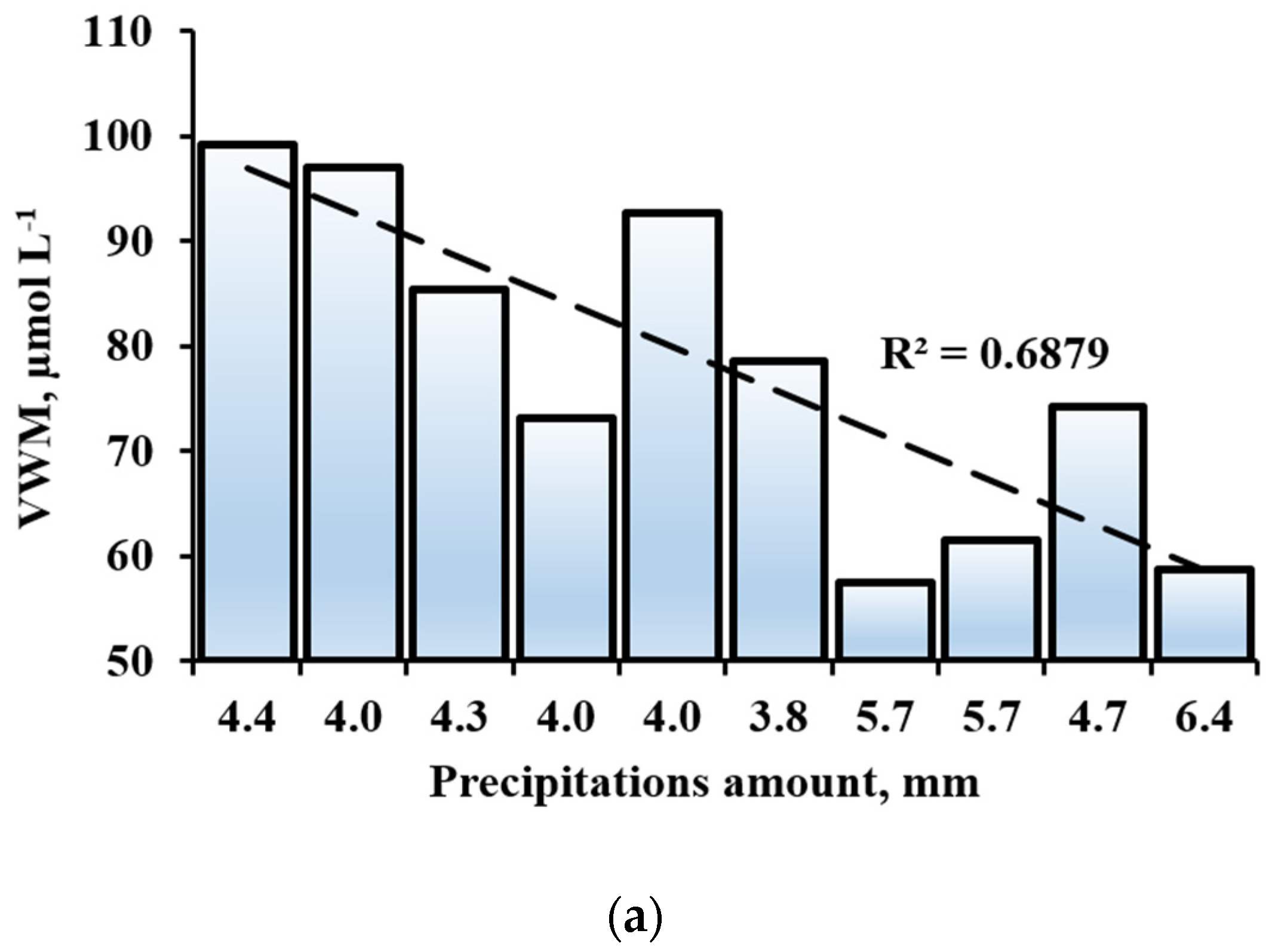
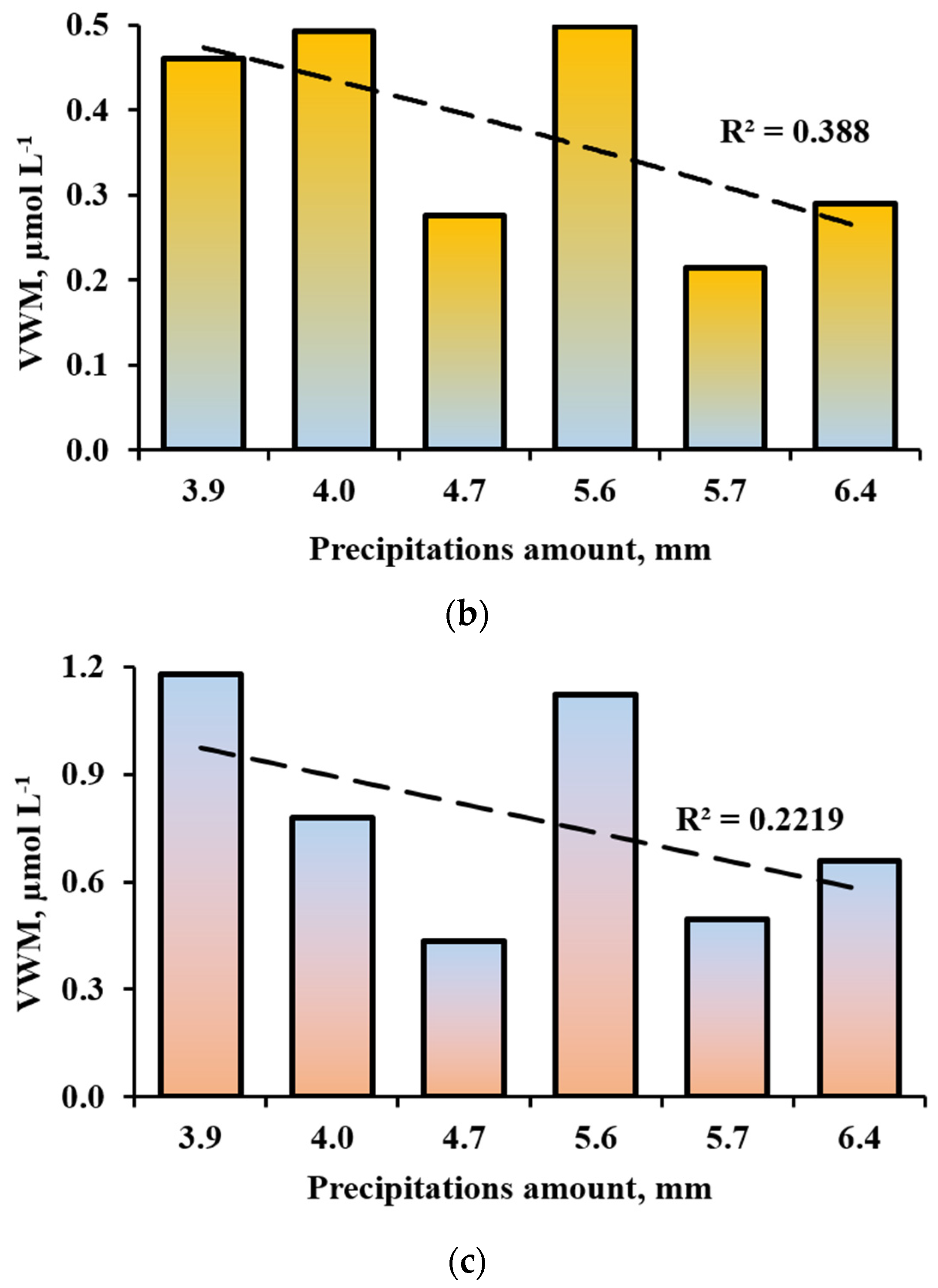
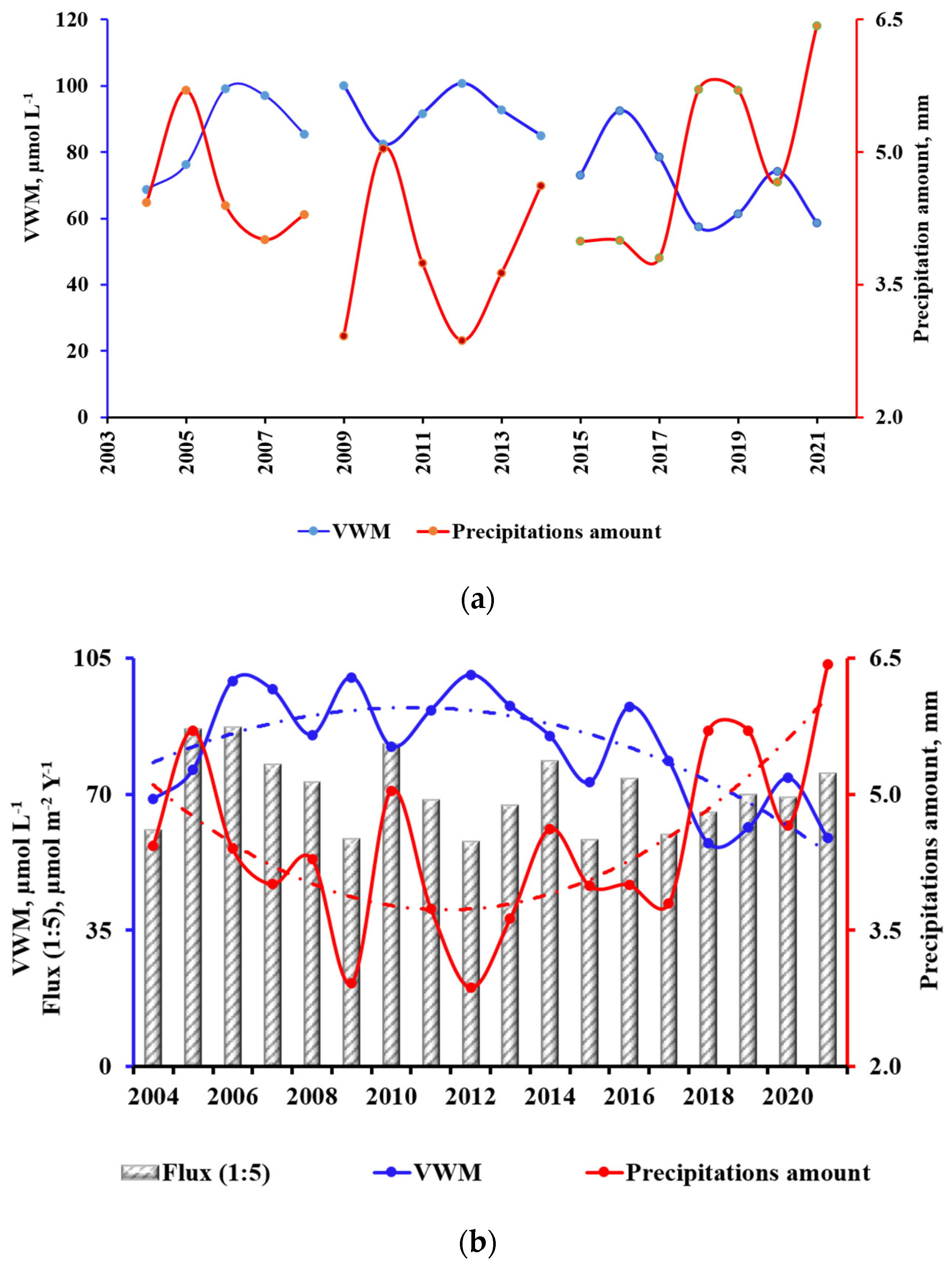
| Nitrogen | Phosphorus | Silica | ||||
|---|---|---|---|---|---|---|
| Wet-Only Sampler | Open Sampler | Wet-Only Sampler | Open Sampler | Wet-Only Sampler | Open Sampler | |
| Max, µmol L−1 | 465.76 | 799.58 | 18.17 | 45.65 | 34.46 | 36.79 |
| Min, µmol L−1 | 17.42 | 17.00 | 0 | 0 | 0 | 0 |
| VWM, µmol L−1 | 71.21 | 86.44 | 0.37 | 1.01 | 0.77 | 1.77 |
| St. deviation, µmol L−1 | 64.81 | 95.53 | 1.45 | 3.98 | 2.69 | 4.56 |
| Nitrogen | Phosphorus | Silica | |
|---|---|---|---|
| Max, µmol L−1 | 62.21 | 1.92 | 25.48 |
| Min, µmol L−1 | 0.47 | 0 | 0.51 |
| Average, µmol L−1 | 10.16 | 0.16 | 3.73 |
| St. deviation, µmol L−1 | 8.15 | 0.17 | 2.95 |
| Nitrogen, µmol L−1 | Phosphorus, µmol L−1 | Silica, µmol L−1 | |
|---|---|---|---|
| Spring | 3.88 | 0.03 | 1.85 |
| Summer | 3.54 | 0.06 | 2.25 |
| Fall | 6.27 | 0.08 | 3.80 |
| Winter | 7.53 | 0.04 | 2.03 |
| River Input, t Year−1 | Wastewater, t Year−1 | With Atmospheric Precipitations, t Year−1 | |
|---|---|---|---|
| Inorganic nitrogen | 7594 (82%) | 1478 (16%) | 94.11 (1%) |
| Phosphates | 171 (35.5%) | 308 (64%) | 1.27 (0.5%) |
| River Input, t Season−1 Summer/Fall | Wastewater Load, t Season−1 | With Atmospheric Precipitations, t Season−1 Summer/Fall | |
|---|---|---|---|
| Inorganic nitrogen | 911.3 (66%)/ 683.5 (58%) | 369.5 (27%)/ (32%) | 93.5 (7%)/ 113.9 (10%) |
| Phosphates | 57.8 (42%)/ 43.3 (35%) | 77 (57%)/ (63%) | 1.41 (1%)/ 2.14 (2%) |
| River Input, t Day−1 | Wastewater Load, t Day−1 | With Atmospheric Precipitations, t Day−1 | |
|---|---|---|---|
| Inorganic nitrogen | 29.5 (66%) | 4 (9%) | 10.9 (25%) |
| Phosphates | 1.9 (47%) | 0.8 (20%) | 1.34 (33%) |
| Year | Sevastopol (Measured) | Evpatoria (Calculated) | Kerch (Calculated) |
|---|---|---|---|
| 2018 | 35.31 | 43.72 | 46.11 |
| 2019 | 23.43 | 35.68 | 27.61 |
| 2020 | 24.20 | 36.88 | 26.64 |
Disclaimer/Publisher’s Note: The statements, opinions and data contained in all publications are solely those of the individual author(s) and contributor(s) and not of MDPI and/or the editor(s). MDPI and/or the editor(s) disclaim responsibility for any injury to people or property resulting from any ideas, methods, instructions or products referred to in the content. |
© 2023 by the authors. Licensee MDPI, Basel, Switzerland. This article is an open access article distributed under the terms and conditions of the Creative Commons Attribution (CC BY) license (https://creativecommons.org/licenses/by/4.0/).
Share and Cite
Varenik, A.V.; Konovalov, S.K. Contribution of Atmospheric Depositions to Inventory of Nutrients in the Coastal Waters of Crimea. Appl. Sci. 2023, 13, 3178. https://doi.org/10.3390/app13053178
Varenik AV, Konovalov SK. Contribution of Atmospheric Depositions to Inventory of Nutrients in the Coastal Waters of Crimea. Applied Sciences. 2023; 13(5):3178. https://doi.org/10.3390/app13053178
Chicago/Turabian StyleVarenik, Alla V., and Sergey K. Konovalov. 2023. "Contribution of Atmospheric Depositions to Inventory of Nutrients in the Coastal Waters of Crimea" Applied Sciences 13, no. 5: 3178. https://doi.org/10.3390/app13053178
APA StyleVarenik, A. V., & Konovalov, S. K. (2023). Contribution of Atmospheric Depositions to Inventory of Nutrients in the Coastal Waters of Crimea. Applied Sciences, 13(5), 3178. https://doi.org/10.3390/app13053178






